A Cursory Look at the New Room Cards of Duskmourn

Split cards have a long history in MTG, appearing as early as the year 2000 with the release of the Invasion block. Since then numerous iterations of split cards have appeared through the years, with the original split cards themselves making occasional comebacks every now and then.
The beauty of split cards, unlike double-faced cards, is that both sides are always accessible at the same time, regardless of where the card is. It does tend to have less creative interactions, and up until this point you can’t ever have split cards and other variants without the half at least being a non-permanent spell.
 (That reminder text really feels wonky to read for some reason.)
(That reminder text really feels wonky to read for some reason.)
Rooms, on the other hand, take a few key elements of double-faced cards, and then sprinkle them on newer variants of split card types. You still have the option of casting both cards with the same type and subtype, but you also get to eventually pay for both sides whenever it is appropriate. Flavor-wise, this meant as the “unlocking” of a room that you initially set on the field.
The concept is very simple, but it works, and feels like a far more practical implementation than… let’s say, a battle card. In fact, as we look at all the room cards revealed so far, we get to see a few interesting things in mind…
(NOTE: These cards are arranged in release order. The lower they are on the list, the later they were revealed during Duskourn spoiler season.)
Room Enchantment Rules Recap
(trimmed, summarized)
- Room is a new enchantment subtype on split permanent cards.
- Each Room card has two halves called "doors."
- When casting:
- Choose one door to unlock
- Pay the mana cost of the chosen half
- Only the unlocked half's abilities apply - After a Room is on the battlefield:
- Unlock the other door by paying its mana cost as a sorcery
- Unlocking is a special action that doesn't use the stack
- Both halves' abilities become active after unlocking - If a Room enters without being cast:
- Both doors start locked
- Unlock either door by paying its mana cost as a sorcery - Characteristics of a Room card:
- On battlefield: Based on unlocked door(s)
- In other zones: Combined characteristics of both halves - Copying a Room:
- Copy has the same doors unlocked as the original
- Locked doors of the copy can be unlocked later
Dollmaker's Shop // Porcelain Gallery

As a two-drop, Dollmaker's Shop is an efficient token generator that's already quite exciting in Commander. In Jinnie Fay, Jetmir's Second decks for example, these tokens can be immediately converted to cats or dogs, creating a self-sustaining engine that's particularly nasty.
decks for example, these tokens can be immediately converted to cats or dogs, creating a self-sustaining engine that's particularly nasty.
The Porcelain Gallery half, while expensive at four colorless and two white mana, offers a potentially game-ending anthem effect. However, opinions are split on its utility. Some view it as a powerful finisher, while others only see it as a "win-more" card, effective when you're already ahead. In practice, it's still likely to find a home in go-wide strategies that can quickly amass a critical mass of creatures.
It is honestly a bit polarizing, and that is actually a very good thing for a card that introduces a new enchantment type for the first time. Being able to cast either half and later unlock the other provides strategic depth that many players have been eager to explore on permanents. However, tracking which "door" is unlocked in paper play could be a bit concerning. This complexity might limit its appeal in faster formats like Modern, but it's less of an issue in Commander, and, of course, not at all on Arena.
In terms of synergies, we have a few very basic possibilities. Even something like Urabrask's Forge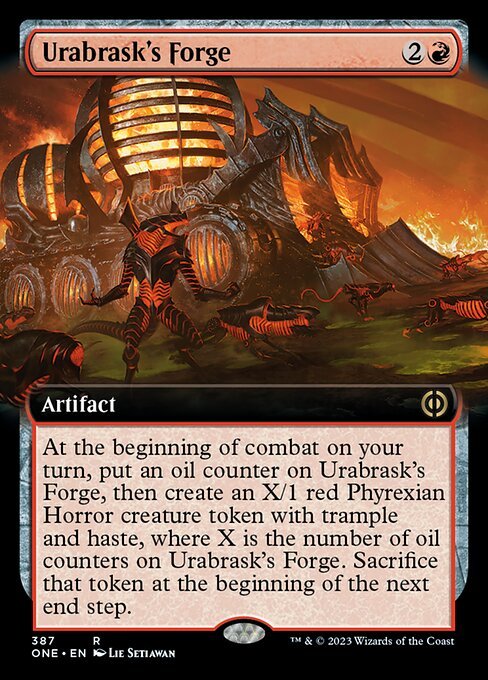 , for instance, can potentially become a powerful token-generating engine with this card. Enigmatic Incarnation enthusiasts are also eyeing this card, as it provides two different mana value options for sacrificing.
, for instance, can potentially become a powerful token-generating engine with this card. Enigmatic Incarnation enthusiasts are also eyeing this card, as it provides two different mana value options for sacrificing.
For competitive constructed formats, the jury's still out. While the Dollmaker's Shop half is efficiently costed, the overall complexity might make it less appealing in streamlined decks. However, some players are already theorycrafting its potential in various archetypes, from white weenie to midrange token strategies.
As hinted earlier, the reminder text has been a sticking point for many, with widespread agreement that it could be clearer. A minor point for sure, but it can get confusing here and there with the atypical wording used.
Ultimately, Dollmaker's Shop // Porcelain Gallery represents an intriguing and powerful new option for mass creature buildup strategies. While the rule complexity might limit its impact in some formats, its potential on others is undeniable. Looking forward to seeing this card as soon as the set officially releases.
Mirror Room // Fractured Realm
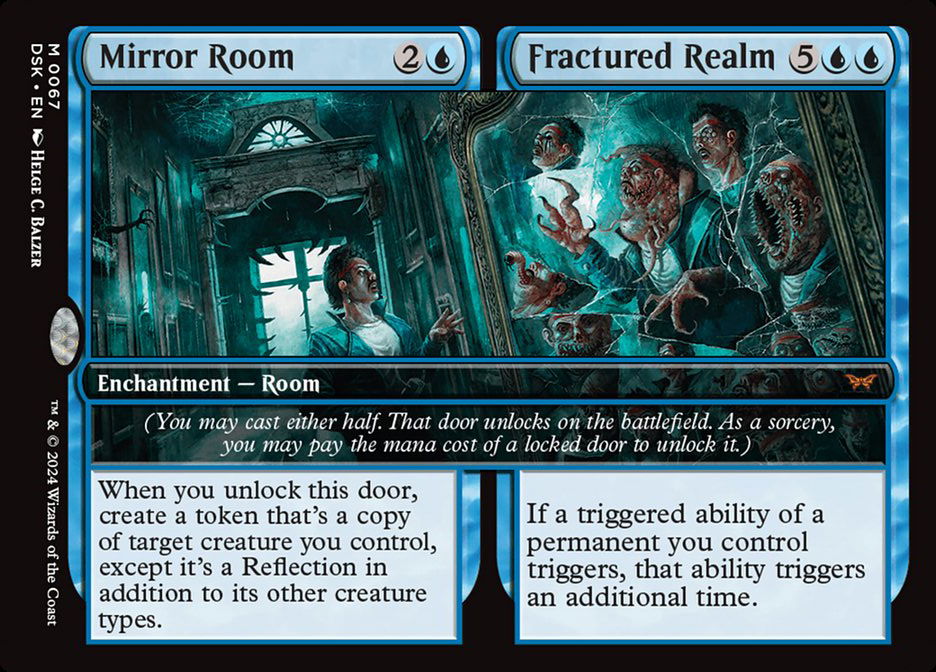
Mirror Room // Fractured Realm is a Swiss Army knife for blue mages... well, kinda sorta. At first glance, it might seem like just another clone effect stapled to a pricey Panharmonicon![]() , but there's more going on here than meets the eye.
, but there's more going on here than meets the eye.
Let's talk about that Mirror Room side first. Three mana to copy a creature? That's a bargain in anyone's book. It's the kind of effect that can snowball a game quickly, especially in Commander where doubling up on a key creature can be backbreaking. And don't sleep on that "Reflection" type addition – it's the kind of seemingly innocuous detail that inevitably becomes relevant in some janky combo down the line.
Now, Fractured Realm is where things get spicy. Seven mana is a lot, no doubt, but what you're getting is Panharmonicon on steroids. We're not just doubling ETB triggers here – we're talking attack triggers, death triggers, upkeep triggers, you name it. It's the kind of effect that makes combo players salivate and value enthusiasts grin from ear to ear.
The flexibility of the Room mechanic is what really sets this card apart. Being able to drop Mirror Room early and then upgrade to Fractured Realm later gives you options at every stage of the game. And we haven't even considered Eerie triggers at this point!
In Commander, this card is going to make waves. Veyran decks are chomping at the bit to slot this in, and Miirym players are already dreaming of the dragon armies they'll create. Even in Standard, I can see Mirror Room finding a home using various blue strategies.
But let's not get carried away. This card isn't without its downsides for sure. Seven mana is still definitely steep, and in faster formats, it might be too slow to make an impact. There's also the complexity factor to consider. Keeping track of which "door" is unlocked could be a headache in paper play, though again, it's less of an issue on Arena.
Still, the potential here is undeniable. Doubling Virtue triggers, accelerating Sagas, copying non-legendary bombs. The possibilities are vast. It's the kind of card that gets brewers' gears turning. Expensive as a whole, sure. But it is also powerful, flexible, and opens up design space in exciting ways.
Smoky Lounge // Misty Salon

Smoky Lounge // Misty Salon is fascinating as an Izzet card, to the point that it is stirring up mixed feelings among players. Don't mind its underwhelming stats as a signpost card, because its mana acceleration alone can be potent if there are enough powerful Rooms in the set. Even if the restriction on mana usage feels limiting.
The Misty Salon side is where things get interesting, though. Creating an X/X flying Spirit based on unlocked doors has potential, but it's a slow build. In Limited, this could be a late-game finisher, but it requires a critical mass of Room cards to be truly effective.
The card's design is pushing Izzet colors if you want a Room-centric deck (at least for now), which is instantly a departure from the usual instant/sorcery focus we're accustomed to seeing. This shift is polarizing; some players are excited about the fresh direction, while others are concerned about the viability of such a strategy.
There's a lot of skepticism about the card's power level, particularly in Limited. Many players are struggling to see how this could be a first-pick-worthy card without significant support from other Room cards. The fact that Rooms don't appear at common rarity (according to MaRo) is raising further doubts about the strategy's consistency in draft. (welp, there's a common Room card already spoiled)
That said, some players are optimistic about the card's potential in constructed formats, particularly if there are powerful Room cards yet to be revealed. The ability to accelerate into more expensive Rooms could enable some interesting strategies.
The complexity of the Room mechanic itself is also a point worthy of discussion. It seems innovative enough, but the difficulty of tracking which doors are unlocked can be a headache (Strike three!), given other things that we need to track on the battlefield.
Ultimately, Smoky Lounge // Misty Salon feels like a card that's difficult to evaluate without seeing more of the set. Its power level will largely depend on the quality and quantity of other Room cards. While it may not be an immediate standout, it could be a sleeper hit if the Room archetype proves to be stronger than initial impressions suggest. The true impact of this card, and the Room mechanic as a whole, will only become clear as we see more previewed cards in the next few days. (and thus this specific comment will be struck out)
Central Elevator // Promising Stairs
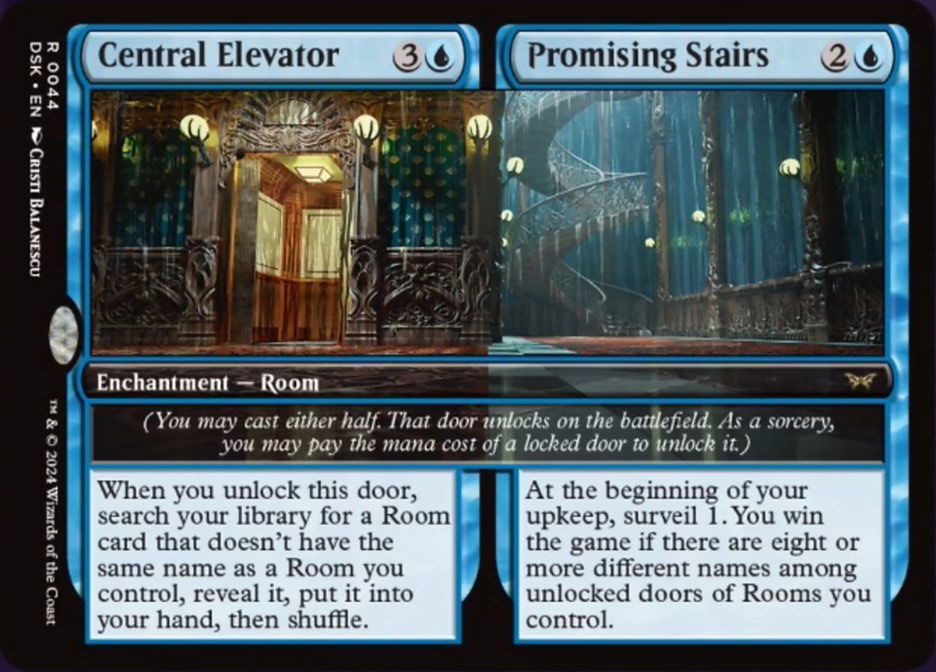
The Central Elevator side is a solid tutor effect for Room cards, which could be crucial in assembling a critical mass of Rooms. At 3U, it's reasonably costed for what it does (IMHO), especially considering the flexibility of the Room mechanic.
But it's the Promising Stairs side that's really turning heads. At 2U, it offers a potential win condition that's both intriguing and potentially achievable. The requirement of eight different names among unlocked doors translates to just four fully unlocked Room cards, which is a lot more attainable than it might first appear.
In fact, the card is already drawing comparisons to other alternative win conditions like Thassa's Oracle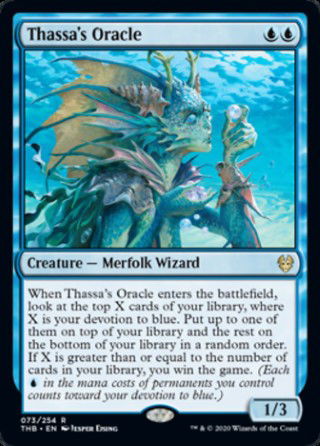 , albeit a slower and more challenging one to pull off. Once again, the fact that it only requires four Room cards to win has caught many players' attention, making it seem more feasible than initially thought.
, albeit a slower and more challenging one to pull off. Once again, the fact that it only requires four Room cards to win has caught many players' attention, making it seem more feasible than initially thought.
In Limited, this card can be a fun, if challenging, build-around.Maybe you could make it a Limited goal? Just keep in mind the likely difficulty of assembling enough Rooms in a draft environment.
The synergy with other Room cards is obvious and potent. Smoky Lounge // Misty Salon, which generates mana for casting Room spells and unlocking doors is being seen as a key piece in potentially making this strategy work.
That being said, some players are worried that without strong support, this and other Room cards might end up being bulk rares. The "parasitic" nature of the mechanic is also raising eyebrows, but we do hope that this has the potential to appear in new sets immediately in the near future.
Funeral Room // Awakening Hall

The Funeral Room side is solid, if unspectacular. It's essentially Bastion of Remembrance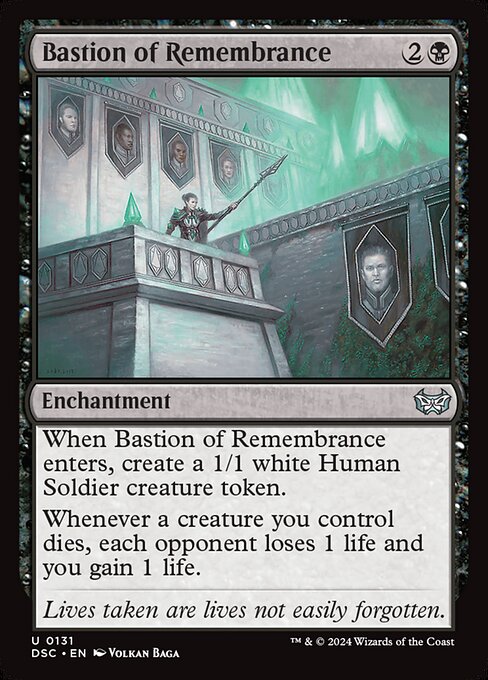 minus the token, but added with a secondary "level-up" effect. In aristocrats strategies, this could be a powerhouse. The Funeral Room side helps you chip away at opponents' life totals while building your graveyard. Then, when the time is right, Awakening Hall can bring it all back for a devastating alpha strike.
minus the token, but added with a secondary "level-up" effect. In aristocrats strategies, this could be a powerhouse. The Funeral Room side helps you chip away at opponents' life totals while building your graveyard. Then, when the time is right, Awakening Hall can bring it all back for a devastating alpha strike.
What's particularly interesting is how this card interacts with the meta. In a removal-heavy environment, the enchantment typing on Funeral Room gives a teeny bit more staying power than creature-based alternatives like Blood Artist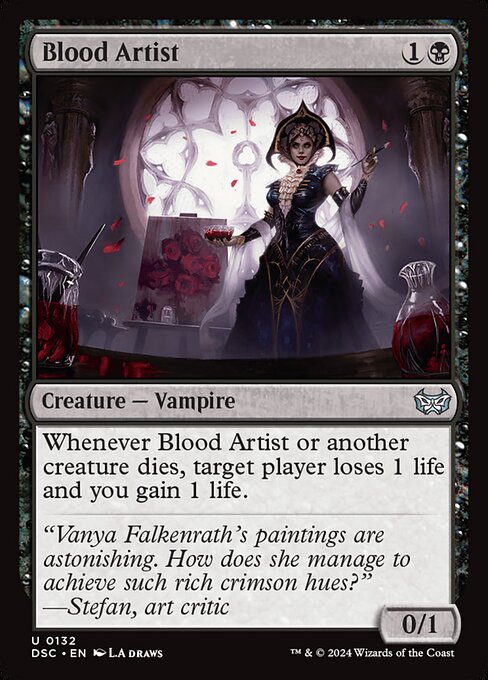 and Zulaport Cutthroat
and Zulaport Cutthroat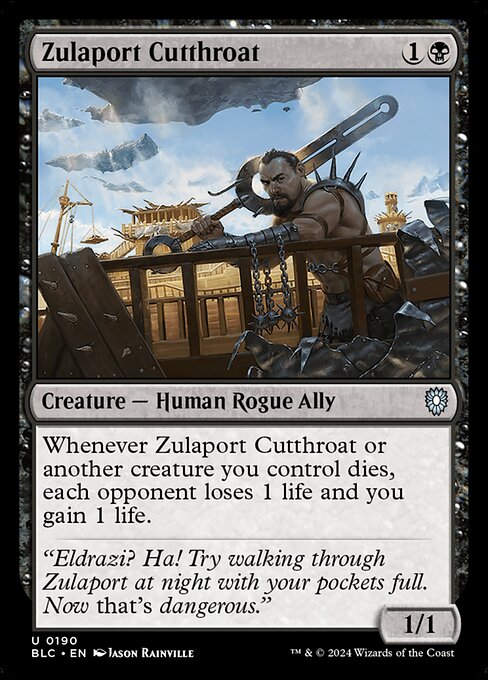 . However, this same quality makes it harder to recur in graveyard-focused strategies.
. However, this same quality makes it harder to recur in graveyard-focused strategies.
I can already see the possibilities. Imagine running this in a Muldrotha deck, where you can potentially cast both sides in the same turn cycle. Or in Karador, where you can repeatedly access the Awakening Hall side from your graveyard. The flexibility here is incredible.
The card's total mana value of 10 is also worth noting. It can't take advantage of cards like Zur the Enchanter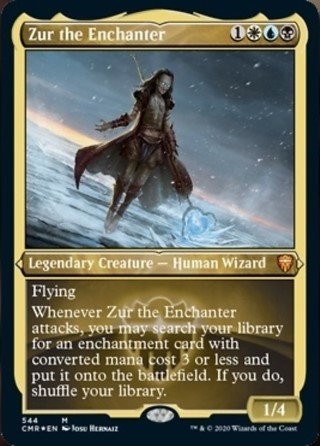 , and you can't cheat it out with cards like Brilliant Restoration
, and you can't cheat it out with cards like Brilliant Restoration (well, you can, but you still have to unlock the doors). This balance adds an interesting deckbuilding constraint.
(well, you can, but you still have to unlock the doors). This balance adds an interesting deckbuilding constraint.
What's really interesting is how this plays in different formats. In Commander, it's a no-brainer include for any black-based graveyard strategy. But in Standard? This could be the top end that pushes a midrange black deck into viability, at least in my opinion.
The only thing holding me back from calling this an instant staple is the mana cost on Awakening Hall. Eight mana is heavy, even in Commander. But then again, if you're unlocking that door, you're probably winning on the spot.
One thing's for sure; I'll be keeping an eye on the price of this card. With its versatility and power level, I wouldn't be surprised to see it become one of the chase mythics of the set.
Bottomless Pool // Locker Room
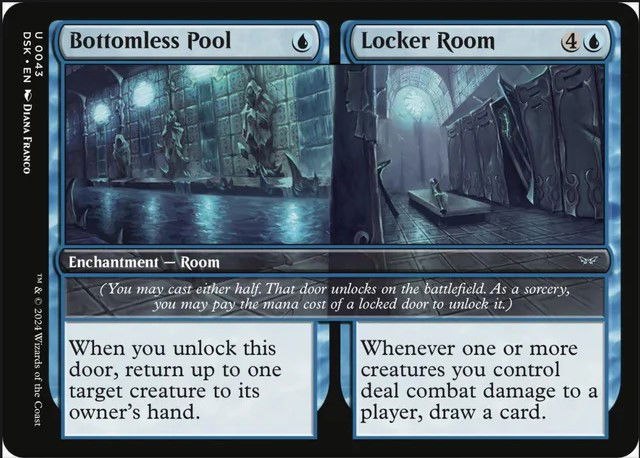
An intriguing entry, but ultimately somewhat underwhelming addition to the Room cycle. At just U, the Bottomless Pool side offers a cheap, reusable bounce effect that could provide some interesting tempo plays in limited. It's essentially a sorcery-speed Unsummon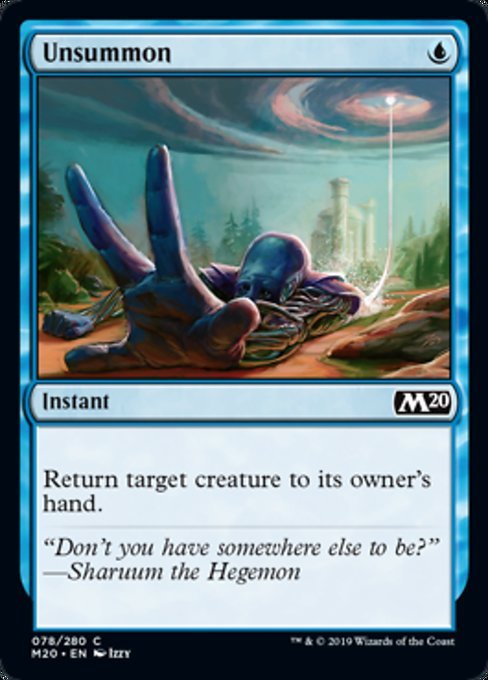 that sticks around, which isn't exciting but could be useful in the right deck.
that sticks around, which isn't exciting but could be useful in the right deck.
The Locker Room side, at 4U, feels overcosted for what it does. It's a watered-down version of Coastal Piracy that only triggers once per combat, regardless of how many creatures connect. This limitation significantly reduces its power level, especially at five mana.
that only triggers once per combat, regardless of how many creatures connect. This limitation significantly reduces its power level, especially at five mana.
Where this card might shine is in its flexibility and potential synergies. In a set with "Eerie" triggers and other enchantment payoffs, having a cheap Room spell could be valuable. The ability to unlock the other side later gives it some late-game relevance, though the high cost of Locker Room is still a concern.
In limited, this could be a solid roleplayer in a blue tempo or control strategy. The cheap bounce can help you stabilize early, while the card draw potential gives you a way to pull ahead in longer games. However, it's likely not a high pick unless the Room synergies in the set are particularly strong.
For Constructed, it's hard to see this making much of an impact outside of very specific Room-focused decks. The effects are just too weak for their costs to compete with other options available in eternal formats.
Glassworks // Shattered Yard

The first common Room we've seen (despite previous declarations that there would be no common Room cards). This could be a game-changer for the Rooms archetype, potentially making the strategy much more viable, albeit not in any serious Constructed formats.
The Glassworks side feels kind of similar to Agate Assault , offering 4 damage for 3 mana at sorcery speed. While not the most efficient removal, its flexibility and synergy with enchantment-matters themes make it appealing. It could probably be even more playable when paired with cards that unlock rooms for free, such as Ghostly Keybearer
, offering 4 damage for 3 mana at sorcery speed. While not the most efficient removal, its flexibility and synergy with enchantment-matters themes make it appealing. It could probably be even more playable when paired with cards that unlock rooms for free, such as Ghostly Keybearer .
.
Shattered Yard is a slower finisher, but one that could prove usable enough to squeeze in the right deck. It combines removal (first half) with inevitability (second half), which I think makes it a strong pick in Limited. The ping effect could also be relevant for Delirium strategies, adding another layer of utility.
This card reminds me of Limited all-stars like Tithing Blade // Consuming Sepulcher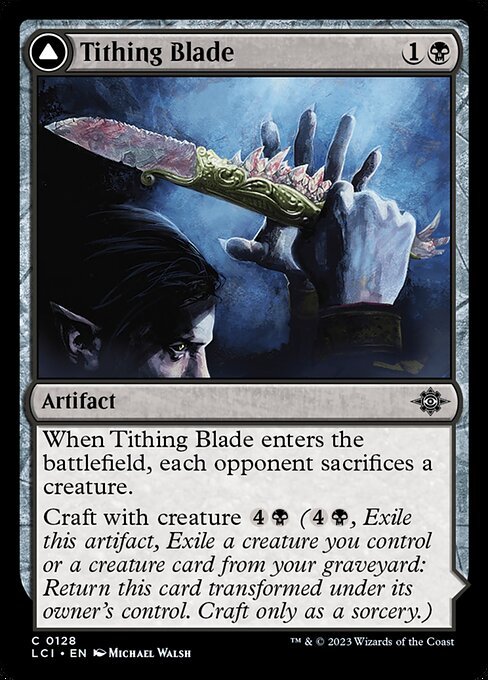 that offer both early interaction and late-game power. The Room typing adds extra value, potentially triggering 'Eerie' effects and contributing to Door synergies.
that offer both early interaction and late-game power. The Room typing adds extra value, potentially triggering 'Eerie' effects and contributing to Door synergies.
Another interesting note. Since unlocking rooms don't count as casting spells, these types of cards might have a weird positive synergy with High Noon . Just saying.
. Just saying.
Greenhouse // Rickety Gazebo

Greenhouse offers mana fixing reminiscent of Chromatic Lantern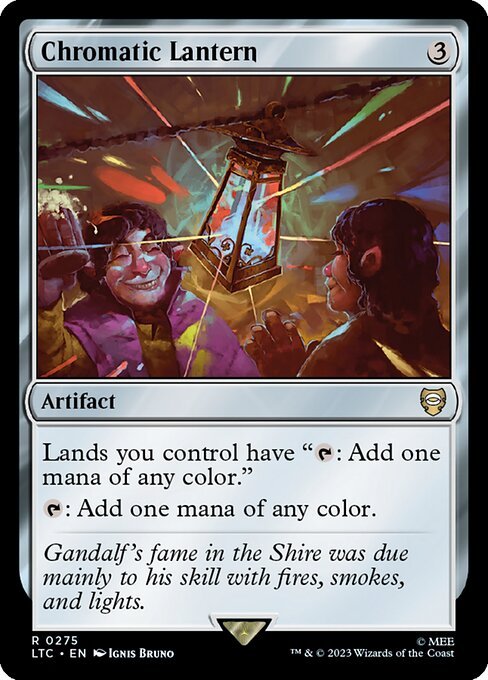 , but without the ramp, and of course, at 2G. This effect uhh... feels overcosted for what it does. Heck, even Wrenn and Realmbreaker
, but without the ramp, and of course, at 2G. This effect uhh... feels overcosted for what it does. Heck, even Wrenn and Realmbreaker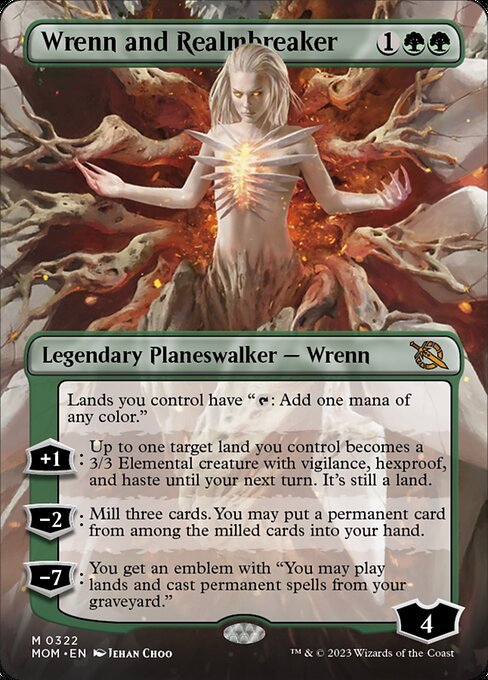 can do at least one more extra thing for the same-ish converted cost during the turn it drops.
can do at least one more extra thing for the same-ish converted cost during the turn it drops.
The Rickety Gazebo side at 3G is kinda decent-ish as an advantage engine, milling four and potentially returning two permanents. It goes to the hand though, so it ain't no Smuggler's Surprise when it comes to its closest recent variants.
when it comes to its closest recent variants.
Limited is actually where this card could thrive, particularly in a "five-color" green strategy. The flexibility to fix mana early or draw cards late gives it some appeal, even if its slow speed and gradual impact won't make it a flavor pick in Constructed formats. After, its mana fixing is outclassed by cheaper or more impactful options (and the card draw is too expensive and unreliable for most competitive decks).
One interesting aspect is how this card interacts with Delirium strategies, potentially enabling the mechanic while also providing a way to recover key permanents.
Overall, it still kind of feels underpowered. It's likely to see play in Limited as a utility card, but probably won't make waves beyond that. Unless there is a killer combo for this card that I completely missed.
Unholy Annex // Ritual Chamber
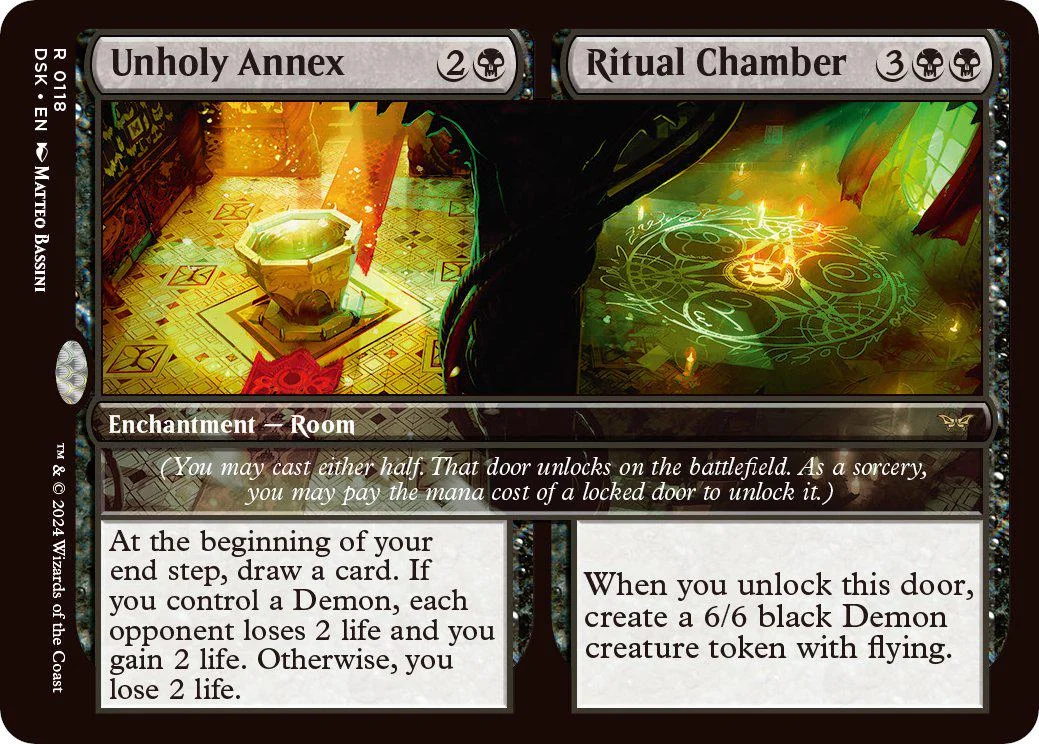
Phyrexian Arena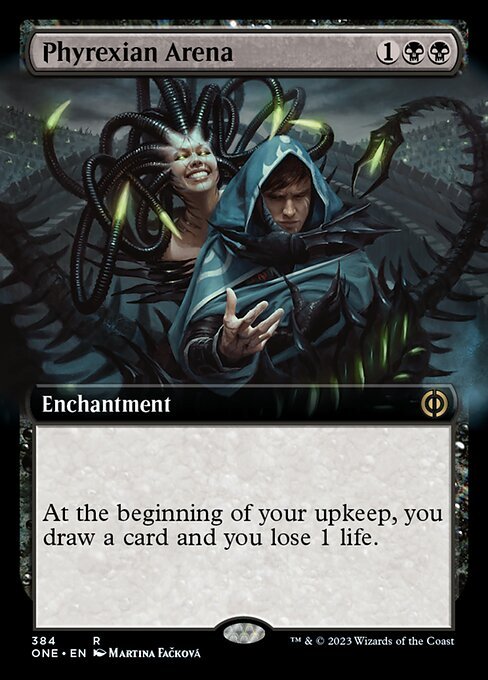 , but with a significant upside (you don't even need to lose life!).
, but with a significant upside (you don't even need to lose life!).
But seriously, the Unholy Annex side is quite solid, providing immediate value by drawing a card on the turn it's played. The Demon synergy adds an extra layer of power, turning it into a life-drain engine if you can keep a Demon on the board. But even without a Demon, the card draw likely outweighs the life loss for most decks.
Ritual Chamber at 3BB provides another solid payoff, creating a 6/6 flying Demon token. This is an efficient rate for a large flyer and synergizes perfectly with the Unholy Annex side.
The flexibility of the Room mechanic really shines here. You can play Unholy Annex early for card advantage and potentially unlock Ritual Chamber later for a big threat. In a Demon-focused deck, this card could be devastating, providing card draw, life drain, and a win condition all in one package, even if you can't pay for everything immediately.
For Standard, I believe this could be a key player in black midrange or control strategies. It curves nicely into cards like Bloodletter of Aclazotz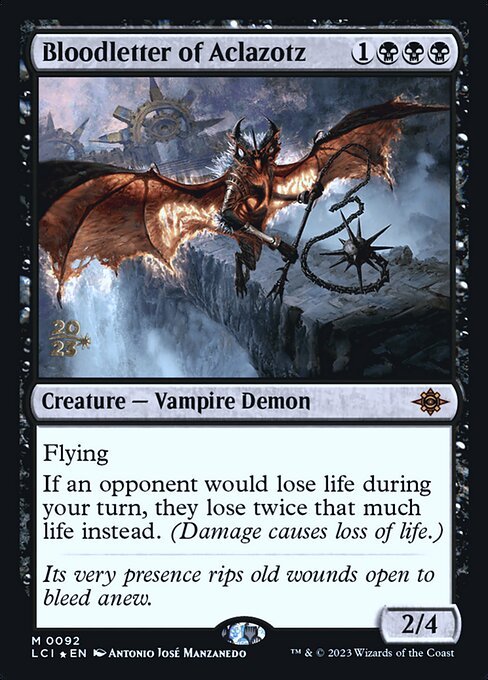 , potentially enabling powerful Demon synergies. In Commander, it's likely to be an auto-include in many black decks, especially those with Demon themes.
, potentially enabling powerful Demon synergies. In Commander, it's likely to be an auto-include in many black decks, especially those with Demon themes.
The main drawback is the life loss without a Demon, but the card advantage should more than make up for it in most scenarios.
Experimental Lab // Staff Room
(Jump Scare! Commander precon card)
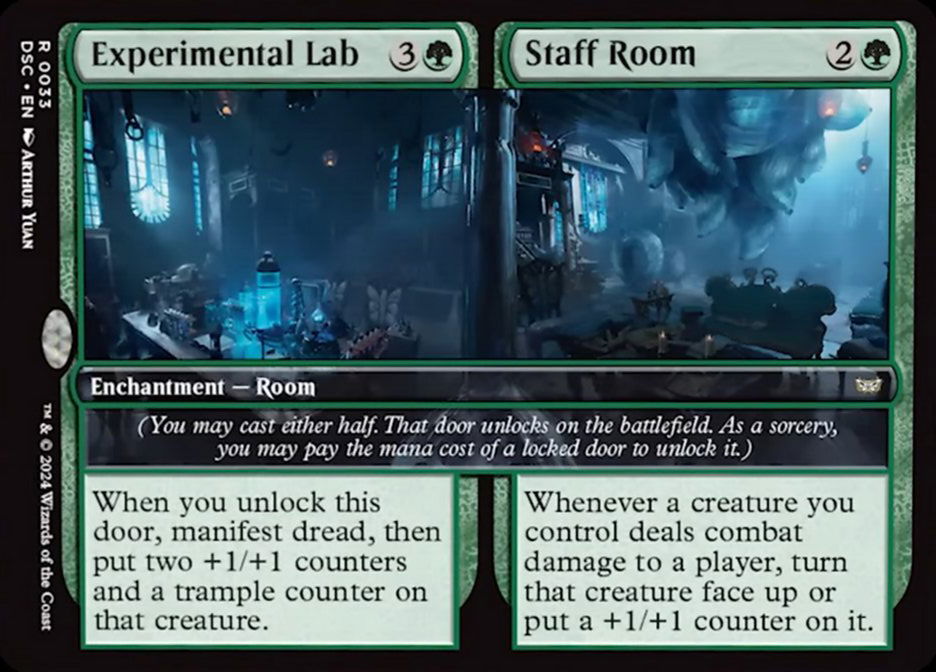
Experimental Lab at 3G utilizes manifest dread, but with the addition of two +1/+1 and a trample counter, turning the manifested card into an immediate 4/4 trampler, creating an instant value-per-value threat. Then, Safe Room at 2G offers consistent free face-ups so long as they deal combat damage, enabling surprise reveals when attacking with face-down cards en masse, or even if you simply want a steady board growth.
Aside from synergizing with its Commander deck's featured commander card, it can also work with other commanders counting +1/+1 counters, such as Animar, Soul of Elements . In decks that can manipulate the top of the library, Experimental Lab becomes even more powerful. The graveyard interaction even opens up reanimation possibilities.
. In decks that can manipulate the top of the library, Experimental Lab becomes even more powerful. The graveyard interaction even opens up reanimation possibilities.
Sorry, I can't really provide much insight for this card. All I can say is that as the featured Room card for the Jump Scare! precon, it ultimately suits its (suggested) Sultai theme the best.
Charred Foyer // Warped Space
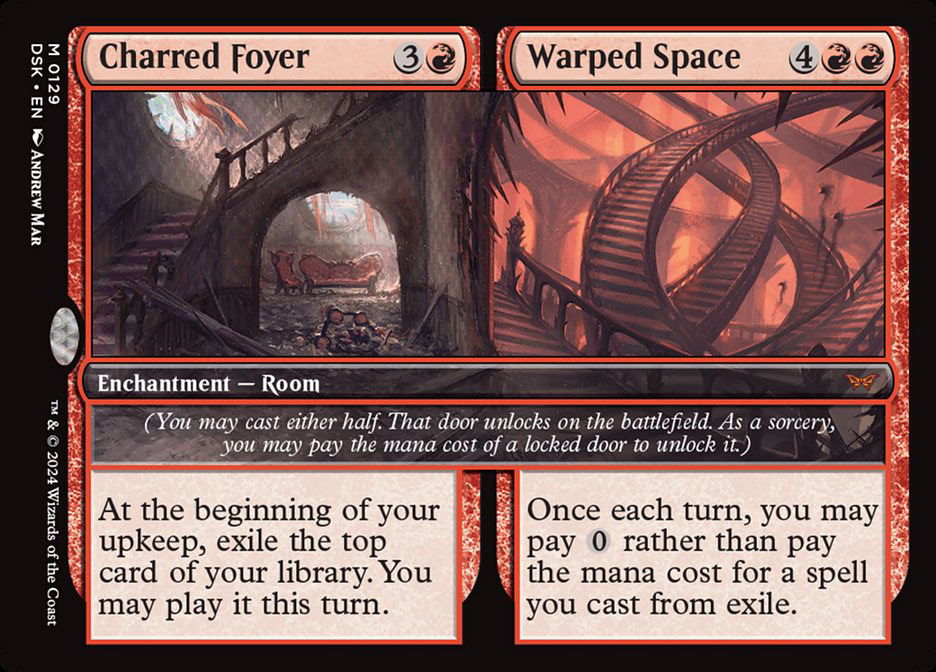
This card presents an interesting but potentially overcosted package. Charred Foyer doesn't impact the board immediately and requires you to essentially skip your turn four, but at least its advantages snowballs really well if you can survive the next turns.
The Warped Space side, costing 4RR, offers a more exciting payoff, but still at a steep price. The ability to cast a free spell from exile each turn is nice, but it requires significant setup. You need to have already unlocked the first side and have other effects to take advantage of it. For example, a previously casted Laelia, the Blade Reforged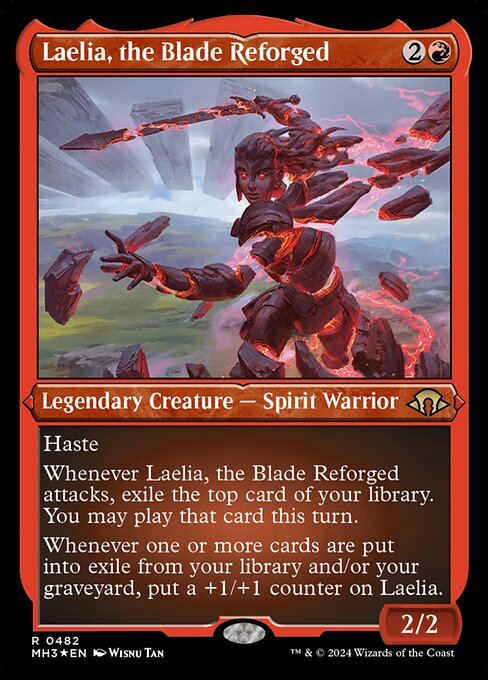 . And even that feels a bit too redundant.
. And even that feels a bit too redundant.
In Standard, this card might find a home very specific jank decks that can afford to take a turn off for future advantage. For Commander, the higher life totals and longer games make both sides more appealing. Cast Charred Foyer early for card advantage, and then unlock Warped Space later for explosive turns.
Overall, while the effects are interesting, the mana costs on both sides feel a bit high for what they do. I am very much looking forward to seeing some broken combos for it eventually revealed later. But at a glance (right now), it doesn't seem to be as impactful as some other Room cards we've seen.
Grand Entryway // Elegant Rotunda
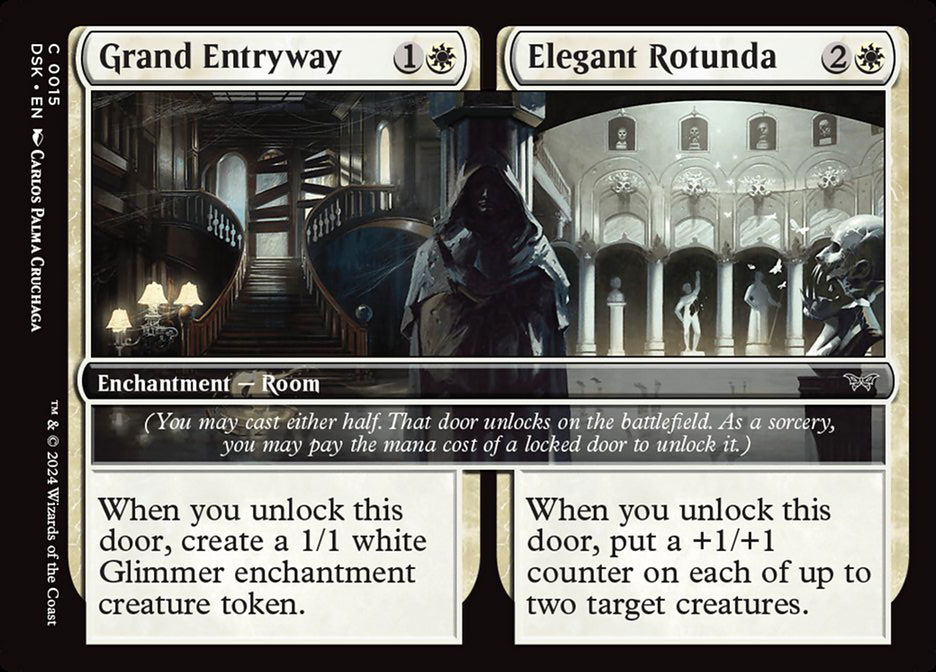
Grand Entryway isn't exactly as efficient as a creature generator for its cost. But, at least the double "enchantment comes to play" trigger for one spell is noteworthy for other things that might care about it. Elegant Rotunda at 2W seems equally modest, putting +1/+1 counters on up to two creatures. Not exciting, but the value seems to even out at least.
The low cost and deployability definitely point to being an Eerie generator, which makes its very simple effects even more universal if you decide to put this into such a dedicated deck. In Limited, for example, this could be a solid role-player if you pick enough things that will benefit from its typing and resolution.
For Constructed, however, it's unlikely to play its "universality" well outside of very specific themed decks.
Private Office // Lecture Hall

Private Office at 2WW is an overcosted conditional board wipe, period. Sorcery-speed destruction of creatures with power 3 or greater is available for less mana, and being an enchantment doesn't justify the increased cost. The fact that it only triggers when unlocked makes it even clunkier.
Lecture Hall at 5UU is extremely expensive for its effect. By the time you can cast this, games are essentially over. And if you are a control deck planning to draw out the turns, chances are creatures aren't even your forte in the first place.
In Standard, it's likely too slow and inefficient to see play outside of very specific control shells, if at all. In Commander, it might find a home, but there are often better options for both board wipes and protection. Heck, the effects don't even seem to be flavorful or exciting enough to make a jank deck dedicated to it.
To summarize, it is a flashy but inefficient card. Nice theme, though.
Secret Arcade // Dusty Parlor
(Miracle Worker Commander precon card)

This is quite a well-tailored card to the precon it belongs to. The Secret Arcade side is particularly intriguing, as it essentially turns your entire board into an enchantment playground. This could be devastating when combined with cards like All That Glitters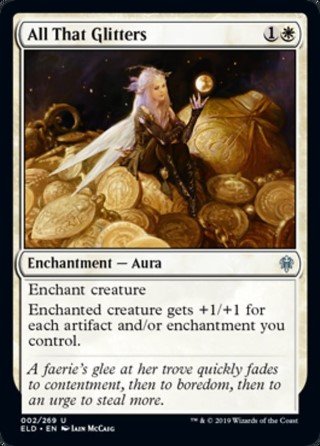 or Ethereal Armor
or Ethereal Armor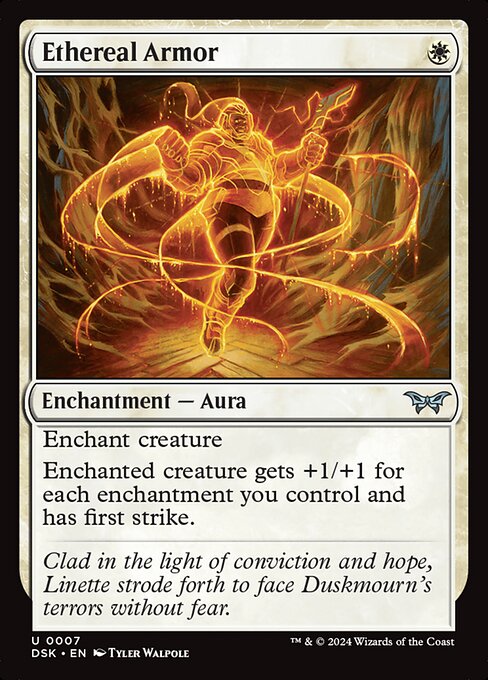 .
.
While it doesn't directly synergize with Aminatou, Veil Piercer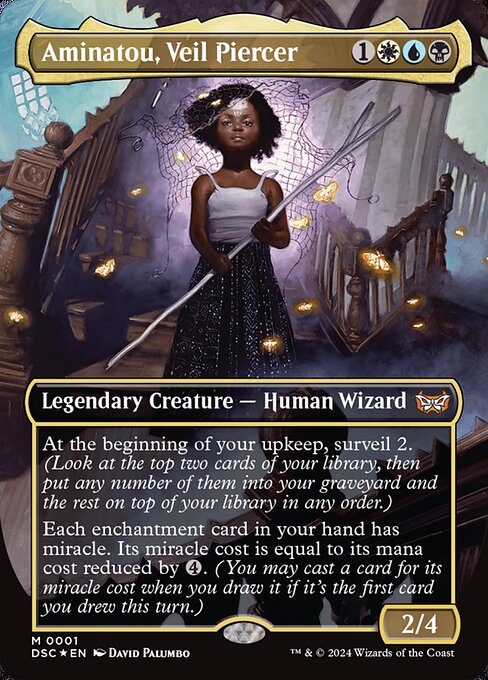 's miracle ability for cards in hand, it does create interesting opportunities once permanents are on the battlefield. I can see this enabling some creative plays, especially in conjunction with flicker effects.
's miracle ability for cards in hand, it does create interesting opportunities once permanents are on the battlefield. I can see this enabling some creative plays, especially in conjunction with flicker effects.
Dusty Parlor's ability to grow creatures based on enchantment casts is potent. You could quickly create formidable threats if optimized well. I'm particularly excited about pairing this with cheap, repeatable enchantments to rapidly buff a key creature.
Comparisons to Enchanted Evening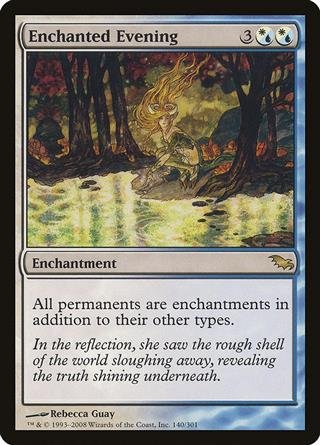 are inevitable, but I think this card has distinct advantages that makes it different. For example, not affecting opponents' permanents or lands makes it less risky in terms of potential blowouts from enchantment destruction.
are inevitable, but I think this card has distinct advantages that makes it different. For example, not affecting opponents' permanents or lands makes it less risky in terms of potential blowouts from enchantment destruction.
While some might question the flavor connection between an arcade and enchantments, I see it as a representation of the magical, transformative nature of games. It's a creative take that adds to the card's charm.
Overall a solid card for where it belongs. Its potential can even go well beyond the Miracle Worker precon.
Cramped Vents // Access Maze
(Miracle Worker Commander precon card)

The Cramped Vents side offers decent removal with a life-gain upside. Nothing much to specify or elaborate here.
Access Maze, however, is where I'm torn. The ability to cast spells for life instead of mana is powerful, but at 5BB, it feels too expensive for what it does. I can see why it's priced this way. It's clearly designed with Aminatou's miracle ability in mind. But outside of that specific interaction, it's hard to justify.
Comparing it to Secret Arcade // Dusty Parlor from the same precon, I find this card less universally useful. Secret Arcade provides a more even level of value, while Access Maze requires a heavier setup and careful management.
And like the other room, the comparison to Bolas's Citadel is inevitable. Though, in my view, Access Maze falls short instead. The one-spell-per-turn limitation and lack of card advantage make it significantly weaker.
is inevitable. Though, in my view, Access Maze falls short instead. The one-spell-per-turn limitation and lack of card advantage make it significantly weaker.
That said, I'm intrigued by its potential in certain strategies. Yuriko decks might consider it for its high mana value, and life gain strategies could potentially leverage the Access Maze side effectively.
Overall, while I'm not sold on its power level right now, I am eager to see how players might find creative ways to make this card broken. It's the kind of design that often leads to unexpected and interesting interactions as it gets more played.
Surgical Suite // Hospital Room
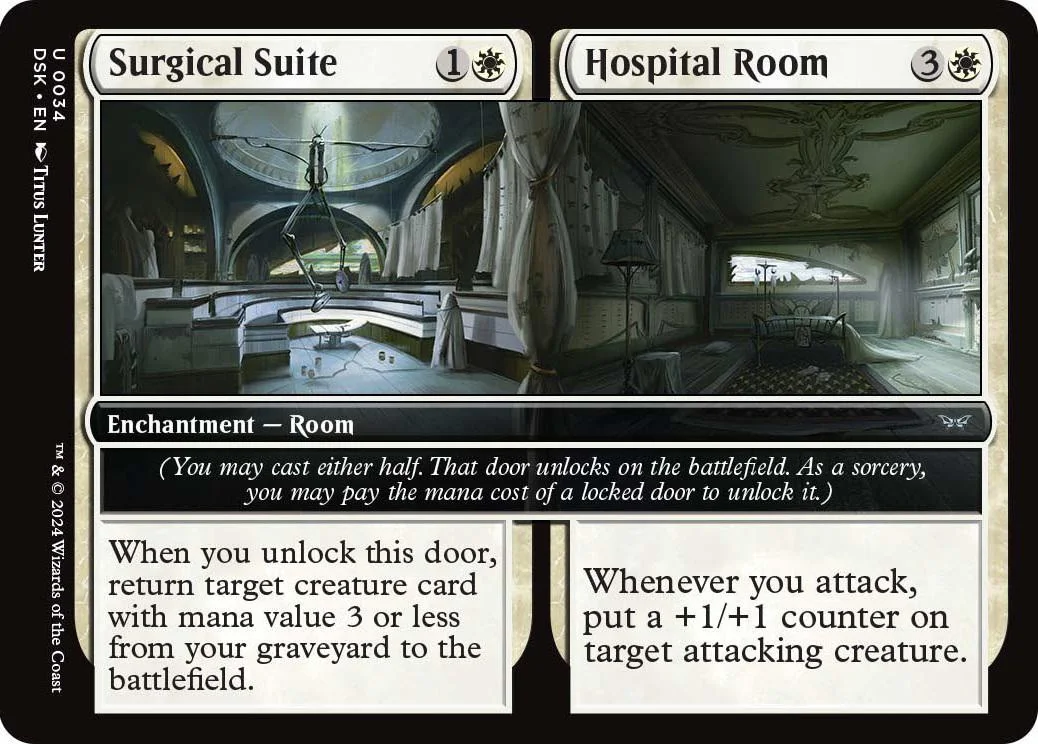
The Surgical Suite side mirrors the current expected cost using such effects, so it alone already works as an alternative. In a set with powerful 3-drops like Abhorrent Oculus , this could lead to some nasty plays in Limited. I can already imagine the frustration of facing down a reanimated 4/3 double striker on turn 3.
, this could lead to some nasty plays in Limited. I can already imagine the frustration of facing down a reanimated 4/3 double striker on turn 3.
The Hospital Room side feels a bit inefficient in comparison. Well, it is not terrible, but I'd rarely be excited to cast it first. Still, I appreciate having the option if and when incremental creature growth could matter.
Its theme and cost allows it to fit into so many archetypes. Reanimator, Eerie tempo, even aggro strategies. That kind of versatility is gold, especially in Limited, and I'd be happy to pick this up early in a draft.
My one gripe is the flavor disconnect on the Hospital Room side. Putting +1/+1 counters doesn't really scream "hospital" to me. But honestly, the mechanical strength of the card outweighs this minor quibble.
Painter's Studio // Defaced Gallery

The Defaced Gallery side at just 1R is what initially caught my eye. It's essentially a Goblin Oriflamme effect, which has proven to always be usable given the right cost and setup. But this version is even better in some ways, because the +1/+0 boost lasts until end of turn rather than just while attacking, which opens up some interesting possibilities with extra combat steps or Fling-type effects.
effect, which has proven to always be usable given the right cost and setup. But this version is even better in some ways, because the +1/+0 boost lasts until end of turn rather than just while attacking, which opens up some interesting possibilities with extra combat steps or Fling-type effects.
The Painter's Studio side at 2R offers the typical red card advantage formula, exiling the top two cards and letting you play them until end of next turn. Not exciting, but not bad either.
What I find somewhat intriguing is its open flexibility. Want a cheap anthem early? Or maybe hold it a turn later for card advantage? It's obviously great in aggressive decks, but that card advantage side could be useful in more midrange or controlling builds too.
While it might not be a format-defining card in Constructed, I wouldn't be surprised to see this show up in Standard decks. After all, we already have a certain "much faster" creature in a certain popular deck that heavily spams a similar strategy nowadays.
Roaring Furnace // Steaming Sauna
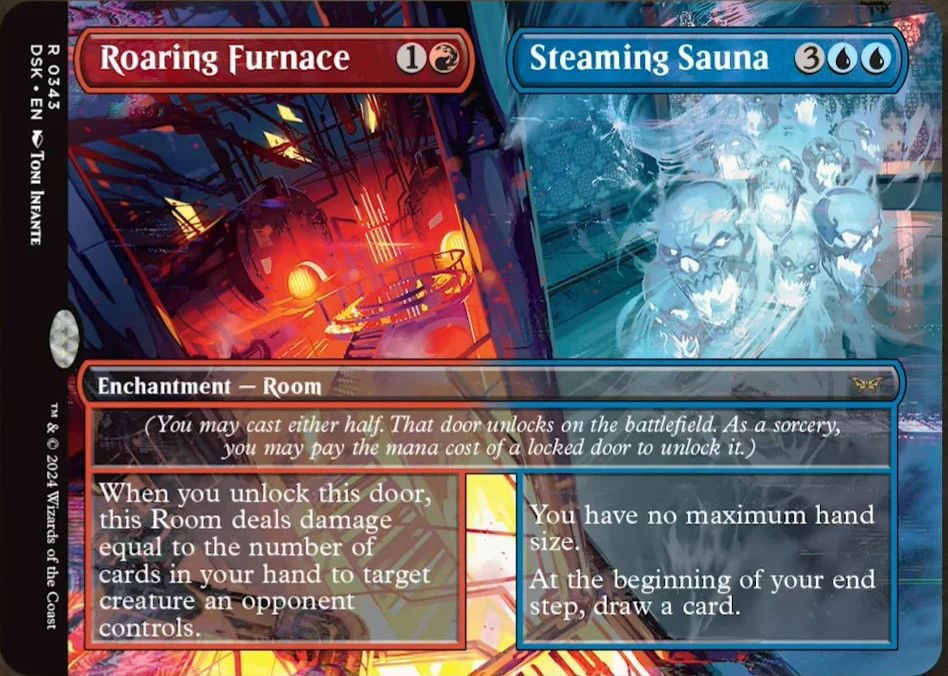
Roaring Furnace offers scalable removal that is akin of a more flexible Sudden Impact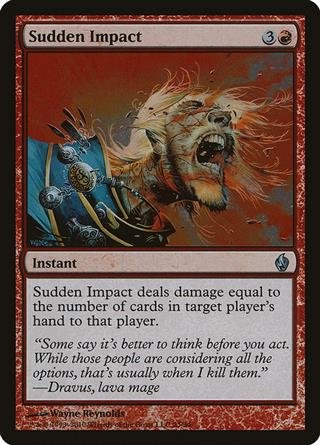 . I love that it can potentially deal with larger threats even with its initial cost and variable effect. The Steaming Sauna is essentially a Howling Mine
. I love that it can potentially deal with larger threats even with its initial cost and variable effect. The Steaming Sauna is essentially a Howling Mine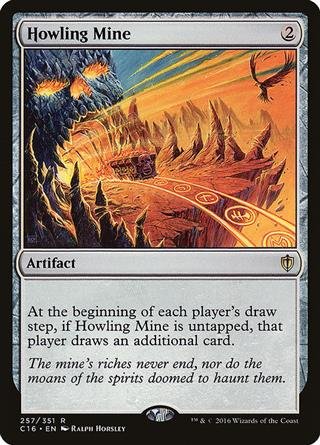 plus Spellbook
plus Spellbook effect, but the end step trigger makes it quite better than similar effects we've seen before. Getting that extra card immediately makes a huge difference in my book.
effect, but the end step trigger makes it quite better than similar effects we've seen before. Getting that extra card immediately makes a huge difference in my book.
In Standard, I can see this being an obligatory slot-in for Izzet or Jeskai control builds. It provides early interaction and late-game card advantage, which is exactly what those decks want. It might get interesting in Temur control as well, where it could support a strategy of ramping into threats while keeping the board under control.
For Commander, this seems like an auto-include in decks like Niv-Mizzet, Parun or Keruga, the Macrosage . The ability to both control the board and draw cards fits perfectly with what those decks want to do.
. The ability to both control the board and draw cards fits perfectly with what those decks want to do.
While some might argue it's too slow for faster formats, I think it's good enough that it might find a home in a more FNM-style deck. In fact, for grindier matchups, this card could single-handedly turn the tide of the game.
Walk-In Closet // Forgotten Cellar
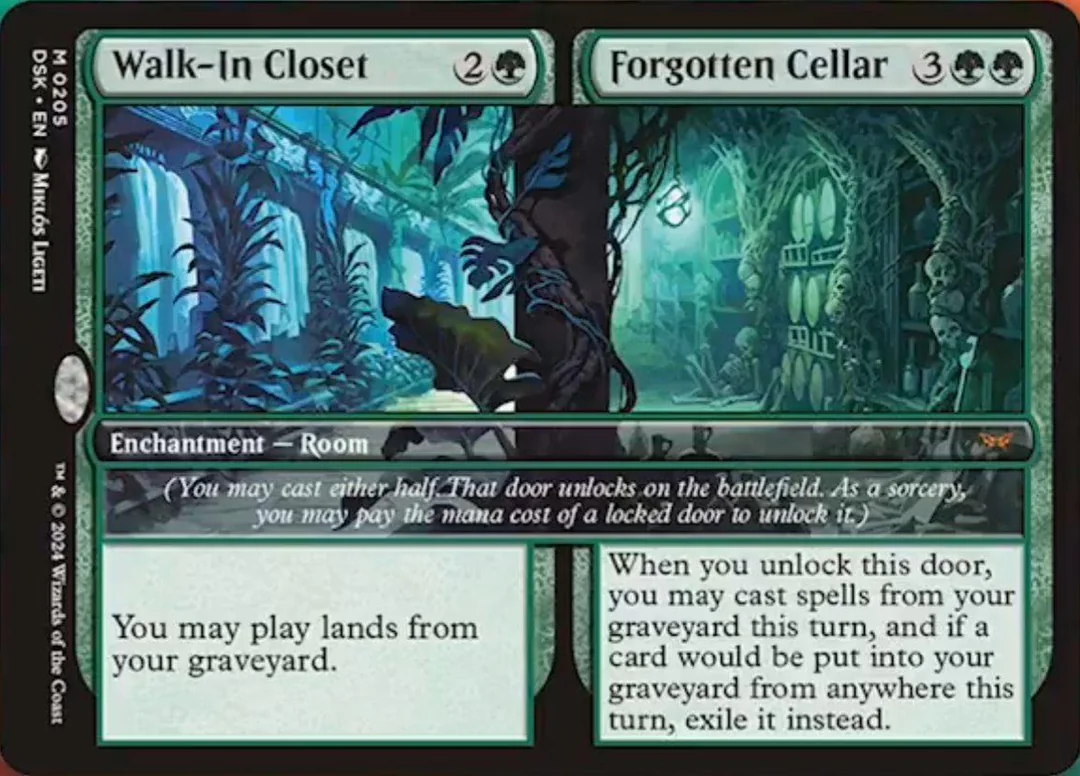
The Walk-In Closet side at 2G is solid. Playing lands from your graveyard is always useful, especially in a format like Commander where fetchlands are prevalent. But what really sets this apart is its flexibility. Unlike Crucible of Worlds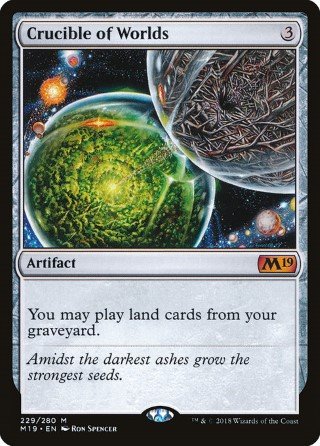 or Ramunap Excavator
or Ramunap Excavator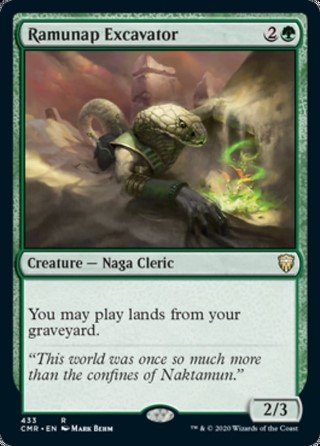 , this can transition into a powerful late-game effect.
, this can transition into a powerful late-game effect.
And what an effect it is! Forgotten Cellar at 3GG is essentially a green Yawgmoth's Will . The exile clause is a smart balancing factor, preventing degenerate loops, but make no mistake; this is still quite notable.
. The exile clause is a smart balancing factor, preventing degenerate loops, but make no mistake; this is still quite notable.
Self-mill is quite the tune here. In a deck running cards like Grisly Salvage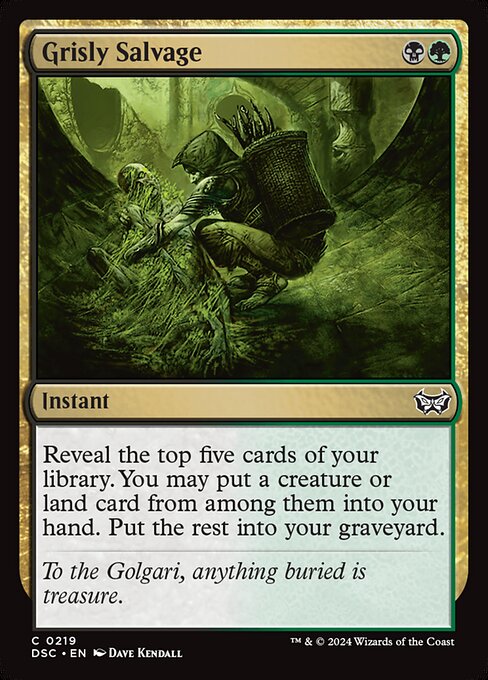 or Mulch
or Mulch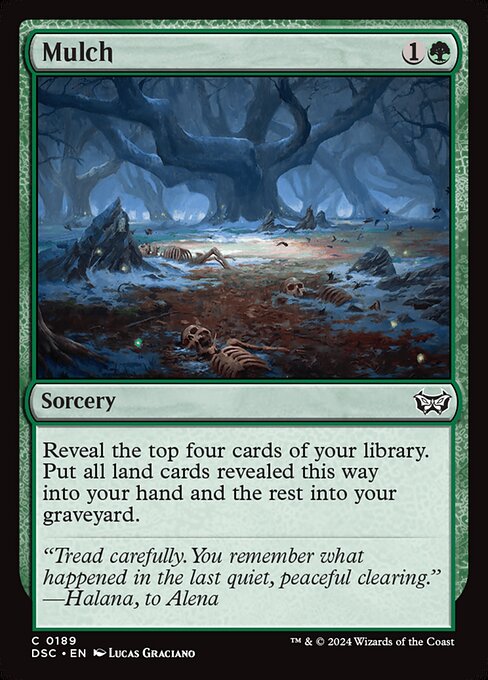 , Walk-In Closet lets you immediately capitalize on advantages, while Forgotten Cellar turns your graveyard into a second hand. This synergy could enable some really explosive turns.
, Walk-In Closet lets you immediately capitalize on advantages, while Forgotten Cellar turns your graveyard into a second hand. This synergy could enable some really explosive turns.
The effects do have some concerns about the color pie implications. But as we saw on previous Room cards, this isn't the first time.
In terms of power level, I think it is somewhat playable enough. Quite the huge payoff, but the mana costs at least still feel appropriate for the effects. Five mana for a one-turn Yawgmoth's Will is a lot, but it's green, so it's all lean.
is a lot, but it's green, so it's all lean.
Defiled Crypt // Cadaver Lab
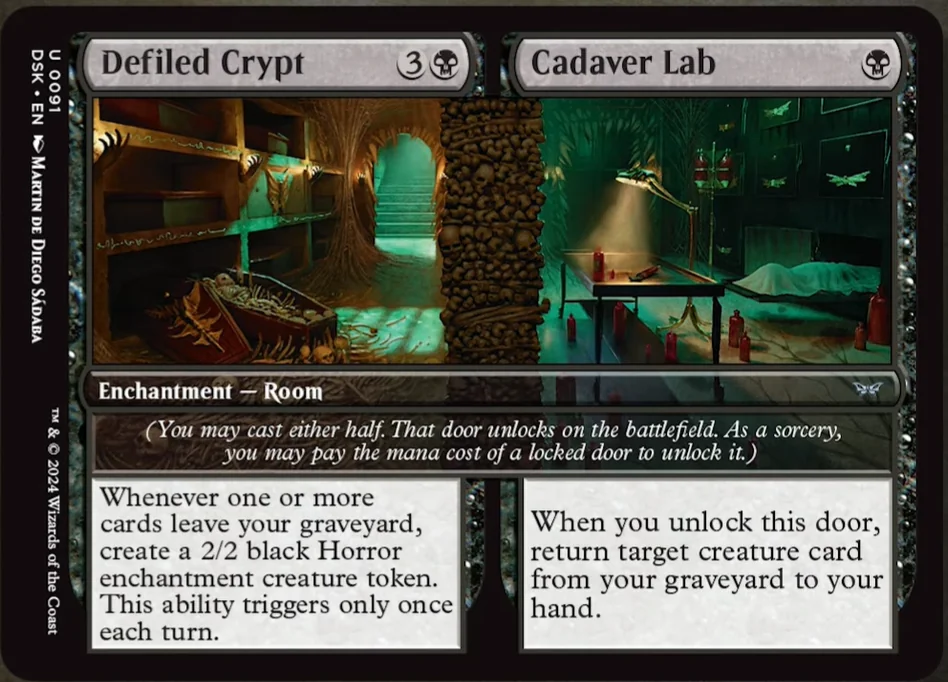
The Defiled Crypt side at 3B offers repeatable token generation. What's particularly interesting for this is that it triggers off any card type, not just creatures. This opens up some intriguing possibilities with cards like Underworld Breach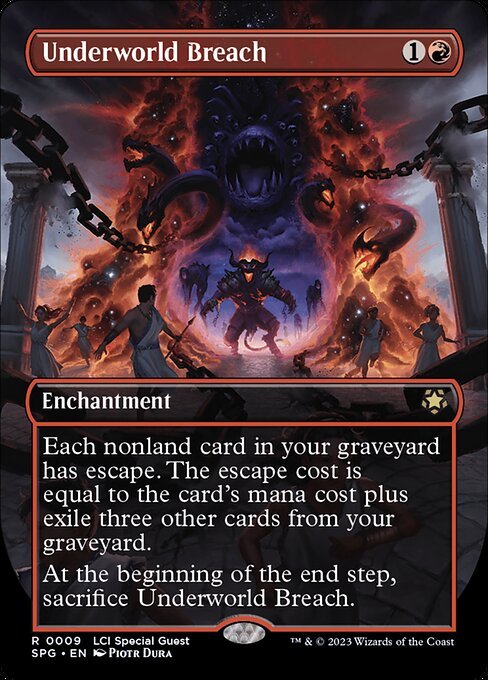 or Muldrotha, the Gravetide
or Muldrotha, the Gravetide . The "once per turn" clause is a bit of a bummer, but probably necessary to prevent easy infinite combos.
. The "once per turn" clause is a bit of a bummer, but probably necessary to prevent easy infinite combos.
Cadaver Lab at B is a steal. One mana for a Raise Dead effect is already solid, but having it attached to the token-generating side makes this card incredibly flexible. In the early game, you can use it to recur a key creature, while in the late game, you can leverage both sides for maximum value.
effect is already solid, but having it attached to the token-generating side makes this card incredibly flexible. In the early game, you can use it to recur a key creature, while in the late game, you can leverage both sides for maximum value.
So, Meren of Clan Nel Toth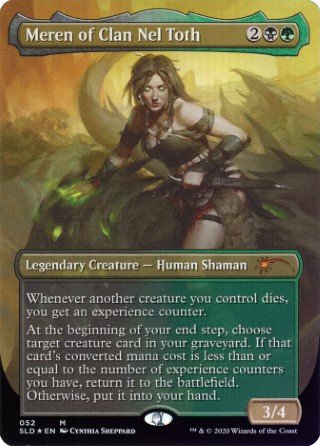 Commander deck anyone? The ability to generate tokens while recurring creatures fits perfectly with her strategy. Plus, being an enchantment makes it harder to remove than something like Tortured Existence
Commander deck anyone? The ability to generate tokens while recurring creatures fits perfectly with her strategy. Plus, being an enchantment makes it harder to remove than something like Tortured Existence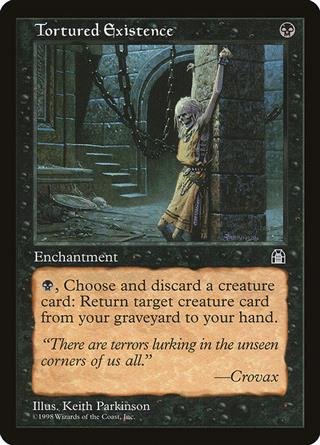 .
.
One clever interaction that was pointed out is with Luminous Broodmoth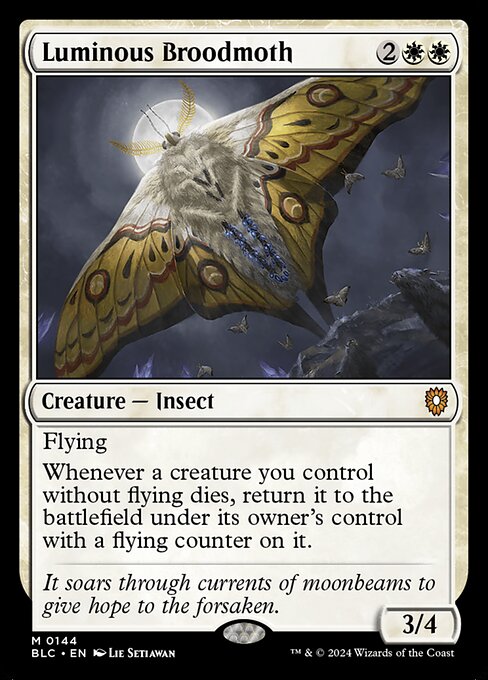 . You can sacrifice a creature without flying, get it back with Broodmoth, then use Cadaver Lab to return it to your hand and do it all over again.
. You can sacrifice a creature without flying, get it back with Broodmoth, then use Cadaver Lab to return it to your hand and do it all over again.
Moldering Gym // Weight Room

The Moldering Gym side is basically your average two-drop ramp with enchantment synergies. The Weight Room side then goes ham with Manifest dread plus three +1/+1 counters? Quite the nasty surprise for an instant face-down bruiser there.
Comparisons to Beanstalk Giant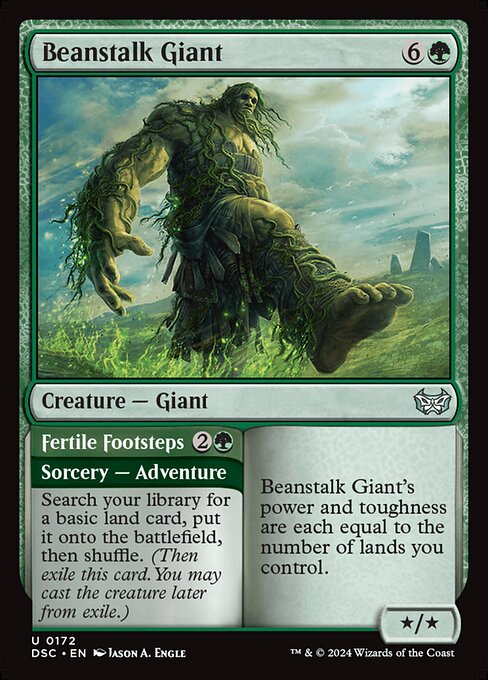 and Dance of the Tumbleweeds
and Dance of the Tumbleweeds are flying around, and for good reason. This card offers similar flexibility, letting you ramp early and still have a potential beater later. Some folks are even calling it an upgrade, though the debate's still out on that one.
are flying around, and for good reason. This card offers similar flexibility, letting you ramp early and still have a potential beater later. Some folks are even calling it an upgrade, though the debate's still out on that one.
In Limited, I can see it being a nice pick in draft. But for Constructed, it's harder to gauge. Beanstalk Giant saw play in Standard way back, so there's precedent for this type of effect. The enchantment typing and graveyard interaction could make it relevant in the right deck.
saw play in Standard way back, so there's precedent for this type of effect. The enchantment typing and graveyard interaction could make it relevant in the right deck.
In Commander, some even consider cutting Rampant Growth for it. The manifest synergy is just too tempting.
for it. The manifest synergy is just too tempting.
On a lighter note, I agree with the flavor win here. The idea of a moldering gym in a horror house is delightfully creepy. Whatever's coming to get you out of that Weight Room is going to be swole as heck.
Spiked Corridor // Torture Pit
(Endless Punishment Commander precon card)

This is quite the interesting Room card, as it is the first one so far that has the exact same four mana cost on both sides.
As such, the Spiked Corridor side is drawing comparisons to Burn Down the House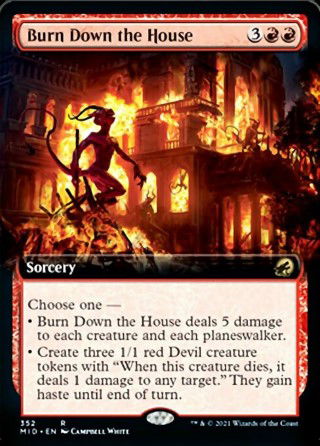 (but at a better rate), which actually becomes kinda funny when you consider the other side. This is because the Torture Pit side only tangentially synergizes with it. Still kinda fun though, even if the fact that it only buffs noncombat damage to opponents can be a point of contention.
(but at a better rate), which actually becomes kinda funny when you consider the other side. This is because the Torture Pit side only tangentially synergizes with it. Still kinda fun though, even if the fact that it only buffs noncombat damage to opponents can be a point of contention.
Since both sides have the same cost, there's an interesting debate about which side to cast first. Some argue for Torture Pit to set up bigger plays, while others prefer the immediate board presence of Spiked Corridor. But hey, as most modal cards have proven time after time, simply having another option always provides better responses for more situations.
In the context of the Commander precon to which it belongs, this card is expectedly tailor-made to trigger the commander's ability. Either side can potentially cause life loss on each opponent's turn, leading to a steady stream of +1/+1 counters and card draw. And speaking of Commander, others are already eyeing this for Purphoros and Torbran, though some worry it might be too slow for more competitive builds.
Polluted Cistern // Dim Oubliette
(Death Toll Commander precon card)
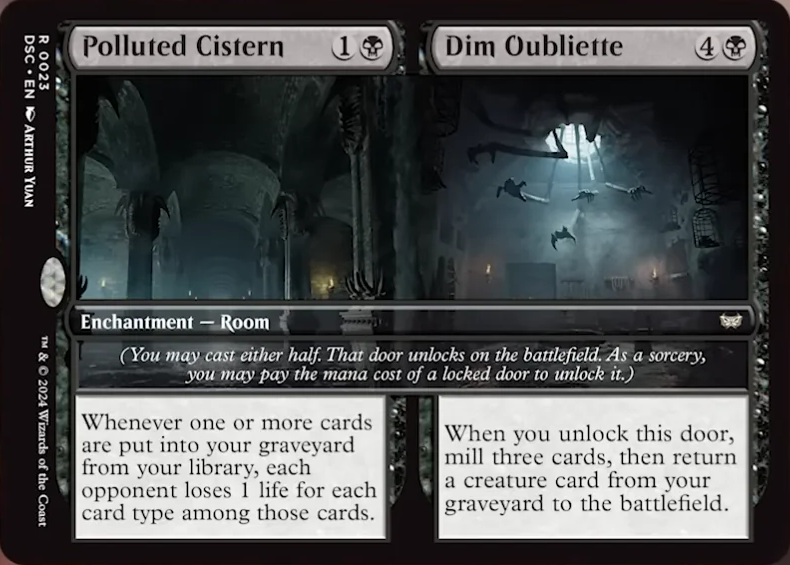
Polluted Cistern is cheap enough to drop early and start applying pressure, so it's already playable enough from that point alone. Winter, Cynical Opportunist 's attack trigger alone could drain up to 3 life from each opponent. As the game progresses, this minor investment can easily snowball. A cheaper, enchantment version of Syr Konrad, the Grim
's attack trigger alone could drain up to 3 life from each opponent. As the game progresses, this minor investment can easily snowball. A cheaper, enchantment version of Syr Konrad, the Grim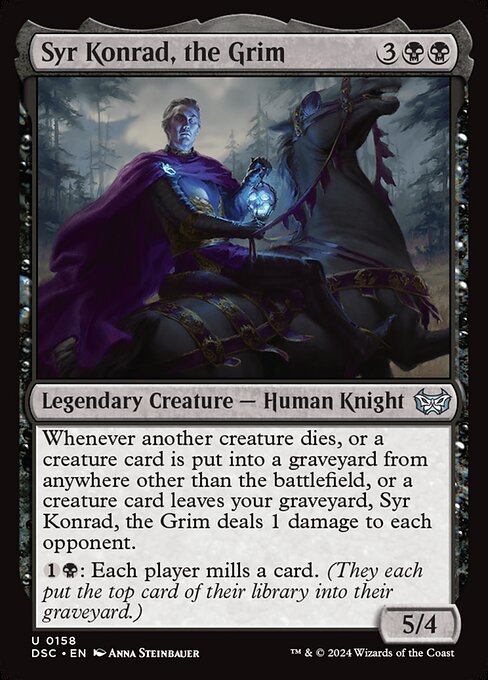 , so to speak, making it just a tad bit harder to remove.
, so to speak, making it just a tad bit harder to remove.
Dim Oubliette is quite pricey, but kind of worth it. Milling three more cards and reanimating a creature plays right into its Commander precon's gameplan. It helps fuel Delirium while providing a way to recover key pieces from our graveyard.
The card basically rewards a diverse graveyard. The more card types we mill, the wider the advantages go in all directions. That being said, even in the context of the Death Toll person, this still requires work, so it's not like it's broken or anything.
If you don't like using it within its particular precon, there are still a lot of juicy alternatives. A few things in mind are The Wise Mothman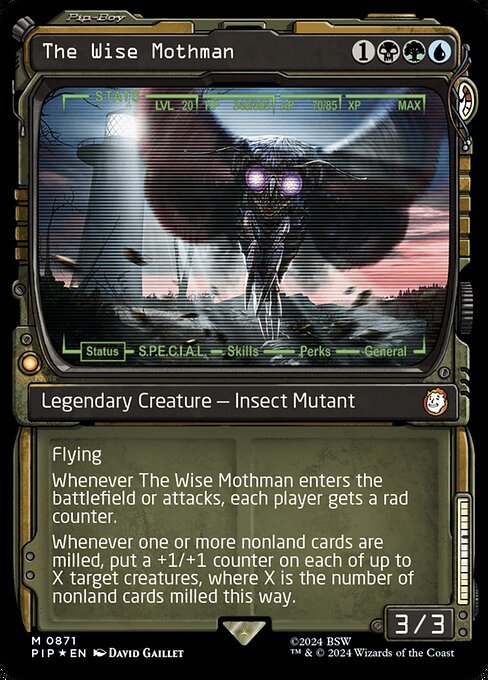 , Sidisi, Brood Tyrant
, Sidisi, Brood Tyrant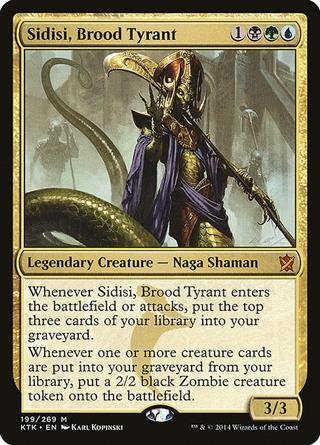 , and Muldrotha, the Gravetide
, and Muldrotha, the Gravetide .
.
Dazzling Theater // Prop Room
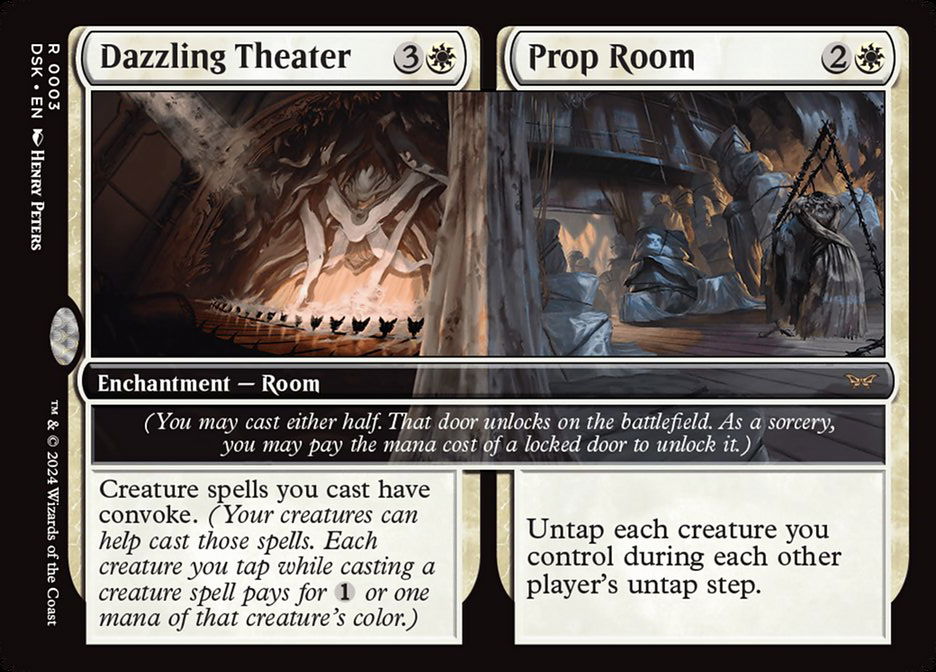
This card taps into a unique dynamic, especially in the world of token-heavy or "go-wide" strategies. An Invasion of Segovia // Caetus, Sea Tyrant of Segovia, but this time for creatures instead. Kind of like a dream come true for those disappointed by Wand of the Worldsoul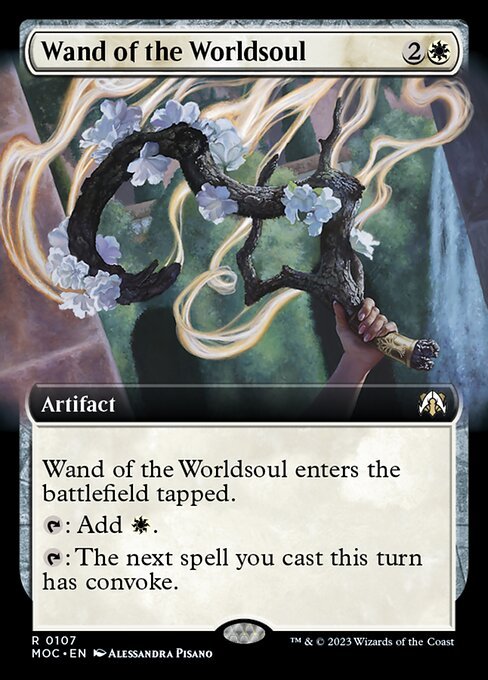
At the same time, Prop Room seems just a tad bit underrated, at least for me. In Standard, it’s being viewed as a niche tool, but it actually seems decent enough, given the cost. Like I said, a perfectly White version of that beloved battle card.
And, of course, everybody pretty much already knows why: convoke to tap down your creatures for spells, drop a bit more again on your opponent's turn. Sure, it doesn't have the same appeal as wrecking your opponent with non-creature spells. But it is still a pretty big deal mana-wise, especially when you want to grind out value or protect yourself in longer multiplayer games.
While Dazzling Theater may seem a little expensive at 4 mana, the potential to build up massive turns where you cast huge spells for virtually free is what makes it a great jank brainstormer.
Needless to say, the card’s biggest drawback is the setup needed. For Standard, such effects and cost are usually too slow to matter. Commander enthusiasts, on the other hand, seem eager to find ways to break it, with that juicy "each other player" clause.
Meat Locker // Drowned Diner

In the words of a certain sarcastic MTG aficionado: utterly unplayable. Gotta fill in for those dud cards I suppose. Next!
Underwater Tunnel // Slimy Aquarium
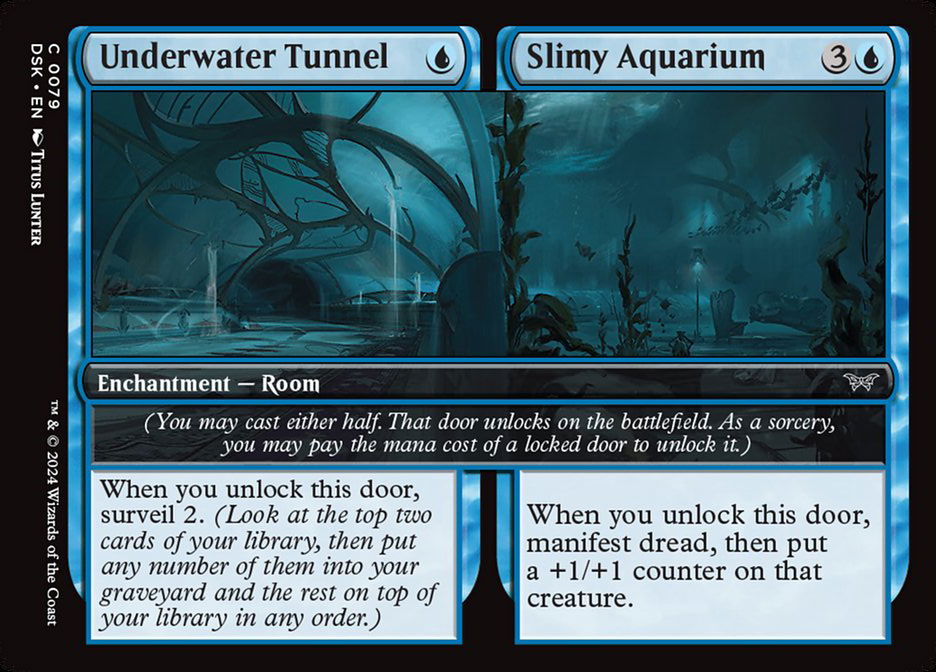
This card seems to fit neatly into an Izzet Room archetype, and the Underwater Tunnel half, at just one mana, is especially critical for getting a Room on the board early. In fact, the one drop cost makes it an easy inclusion in decks that need a cheap Room to unlock, and it's perfect for those planning to sacrifice Rooms later on.
Slimy Aquarium reintroduces a simple manifest dread effect, but it doesn't feel as exciting with just one +1/+counter added. Its value in Limited, at least, comes from creating a presence where you might otherwise be left vulnerable. Even though I am skeptical about how effective this archetype will be in Limited, the card still provides essential utility, reflecting the Room cards' consistent theme of cheap access to both effects now and later on.
Definitely more for Room-heavy strategies and slower, synergy-focused plays. Its low cost and room-activation options make it useful early on or for things like Eerie triggers, but don’t expect it to dominate outside of those niche scenarios.
Ticket Booth // Tunnel of Hate

... And Ticket Booth manages that just simplify it down to just manifest dread itself. Great. I mean, we did ask for common Rooms, so I suppose I cannot complain.
Tunnel of Hate, though, is quite delectable in Limited. An immediate power option that can turn the tide of games, and at common? Sign me up!
But yeah, like the rest of the overcosted common Room cards here, we ain't seeing this anywhere outside Limited. Unless you have a very clever combo for its simple effects.
Derelict Attic // Widow's Walk
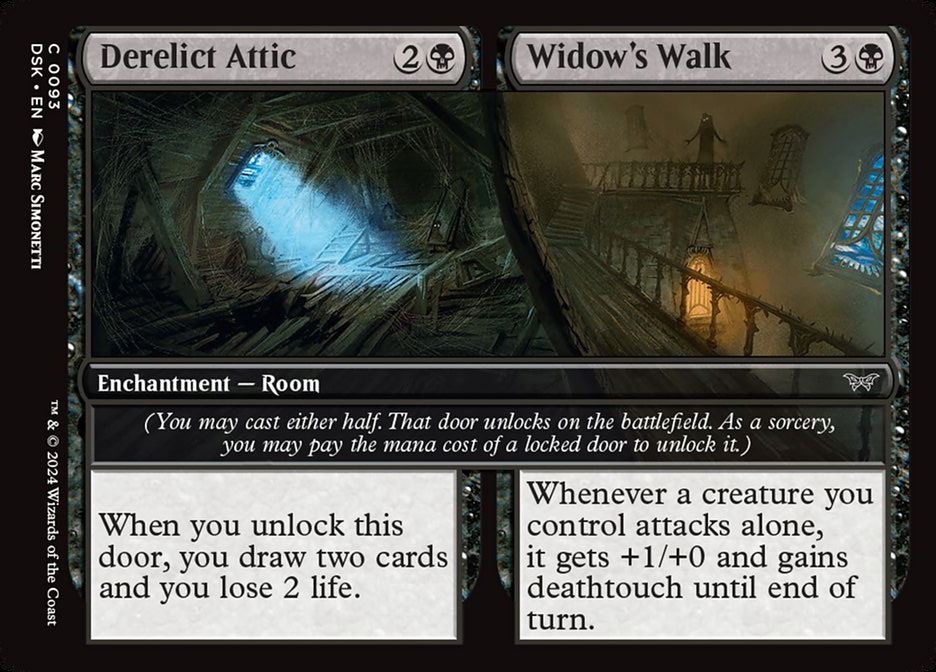
Who in the world requested a nerfed version of Night's Whisper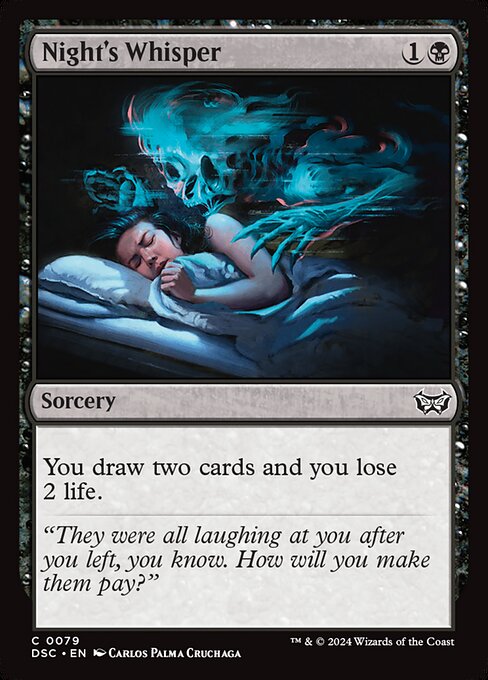 or Sign in Blood
or Sign in Blood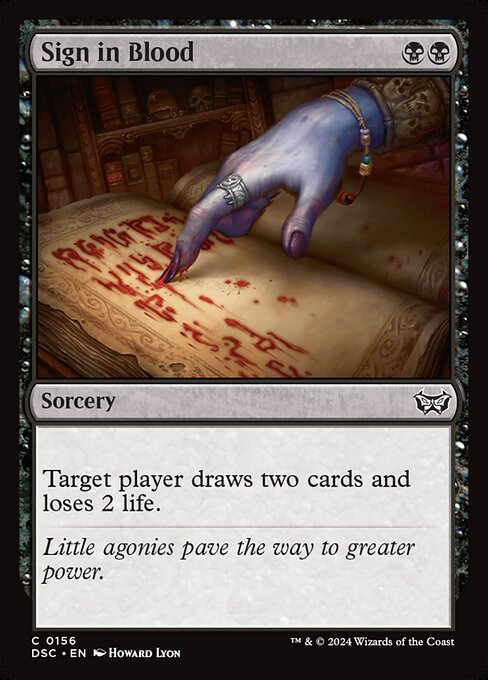 ? While the card draw is valuable, both sides of this card put you behind on board presence, with Widow's Walk even requiring very specific situations to be remotely useful.
? While the card draw is valuable, both sides of this card put you behind on board presence, with Widow's Walk even requiring very specific situations to be remotely useful.
Heck, Widow's Walk ability is so situational, that it might not even align well with typical Limited strategies, where attacking with multiple creatures is often preferred.
About ChrisCee:
A witness since the time the benevolent silver planeswalker first left Dominaria, ChrisCee has since went back and forth on a number of plane-shattering incidents to oversee the current state of the Multiverse.
"Target bird is no longer available. Please leave a message after the last bounce."



